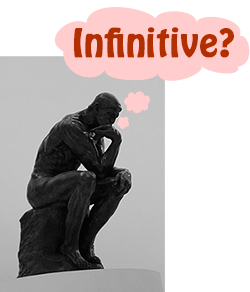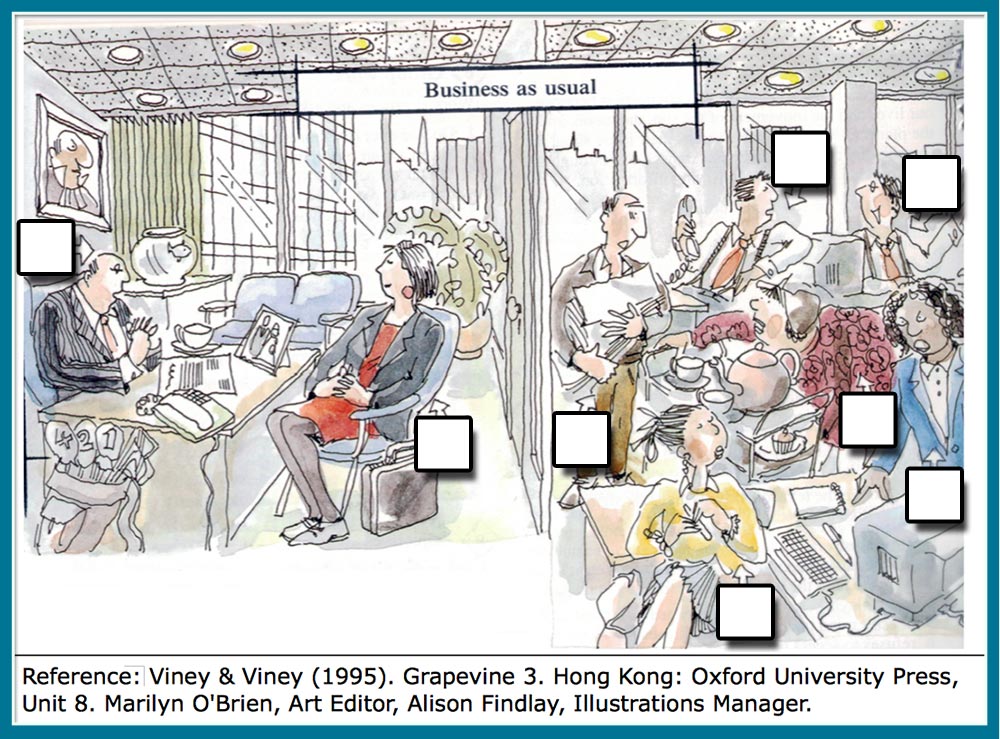Hi there! Welcome to this learning Unit!
You will study and learn one widespread structure in English known as the ‘verb plus infinitive’ (verb + to + infinitive).
For that purpose, there will be different exercises, so you learn its communicative function, structure and its correct use in daily life. You will also improve your speaking, listening and reading skills through several activities at the end of the theory.
We want to tell you that you will have the chance to peep into Law language, that is, the words and expressions used in trials when in Court.
For you to learn as much as possible, follow the instructions. Carry out the topics in the order shown.
Having said so… let’s begin!
By the end of this topic, you will:
• Exchange information using sentences with the structure verb + to + infinitive to identify the intention of the action and to take another verb as a direct object.
Here are the subjects that you are going to study, so, please click on each concept to see the information. If you click on another, the information of the past will be retracted. For better results, we suggest that you study the topics according to the order shown.
|
You will learn about the infinitive and the different intentions that you can express with it. 
Cerón, Adrián. (2014). El Pensador [fotografía]. Tomado de: [https://commons.wikimedia.org/wiki/ File:El_pensador,_Auguste_Rodin.JPG] You will learn the syntactical structure of this type of sentences (verb+to+infinitive) and to use them correctly. E.g:
Don’t forget to take with you an umbrella because it is going to rain.  

Referencias: imag_02: epSos.de (2010). Beautiful Latina Woman Smiling [fotografía]. Tomada de: [https://commons.wikimedia.org/wiki/ File:Beautiful_Latina_Woman_Smiling.jpg] You will learn the verbs that use infinitive in this type of sentences. For example: love, agree, begin, etc.  

Referencias:
imag_05: State Library and Archives of Florida. (1970). Couple on the beach at sunset: Fort Walton Beach, Florida [Fotografía]. Tomada de: [https://www.flickr.com/photos/floridamemory/9101316091/] You’ll learn how the syntactical structures: infinitive + to and infinitve + ing, which are used in the daily life as well as in readings. |
In this session, you will study the correct grammatical structure as well as its proper use and the three different ways you can write them.
Are you ready? Ok, let’s go… good luck!
In the concept titled ‘Linguistic Function’, you revised the simplest form of the structure, that is:
V + to + infinitive
Now, you’re ready to study the two variations of this structure:
1) Verb + to + infinitive
2) Verb + noun + infinitive
Read carefully about every variation to get acquainted with the explanations.
Variant 1: verb + infinitive
Many verbs are followed or can be followed by other verbs. Some of them have to be followed immediately by another verb in infinitive.
Eg. Melanie started to take guitar lessons so she could play in the musical recital of her school.
Now, let’s start practicing. (rehearsing)
Click on the link to open exercise A.
Variant 1: Discrimination
Was it easy? Was it difficult?
Check out how all those sentences had the same variant verb + infinitive.
Now, let’s see if you can discriminate this variation 1 from other structures.
Click on the button to open exercise B and follow the instructions.
Variant 2: verb + noun + infinitive
This structure is a bit different because there’s a noun between the first verb and the infinitive.
Eg.
For Peter, it was a great honor to meet Bill Gates in person.
The secret to manage this second variant is to identify each part of the structure in a sentence.
Look at these examples and identify the components in the second variant.
Now, let’s start practicing. (rehearsing)
All the sentences that you answered in the previous exercise had the structure of the second variant.
It wasn’t difficult but… let’s see how you do in an exercise a little… more difficult.
As an experience, the two variants that you’ve studied are easy to use and find in a sentence.
Don’t forget to review all the topics you’ve studied so far to get ready for the next topic: Vocabulary! You can answer the exercises quickly.
Good luck and see you soon in Lexicon!
Hello! Welcome to the third part of the topic “Sentences with structure verb + to + verb”!
In this part, you’ll learn several verbs that are used in each variant that you studied in this topic.
But… first, let’s see how good your memory is. Do you remember what until now you’ve studied?
Complete the synoptic table with what you’ve learnt in the last two parts of the topic “verb + to + verb”
Was it easy? Was it difficult? In case you need to review, you can return to the other parts of the topic by giving click here.
If for you, it was straightforward then… you’re ready for leaning the Lexicon part of the topic.
In the Lexicon part you won’t only learn verbs that are used in each variant but five strategies too that, in a future, will help you to learn any vocabulary you need in English or any other language.
Two essential suggestions:
Ready for learning? Ok, let’s go and good luck!
As you surely remember, there are two variants in the sentences that have structure verb + to + verb.
Each variant uses specific verbs, and if you learn them, you’ll be able to identify and use each option correctly.
Here are the lists of verbs of each variant:
Click on each one so you can download the list of each variant and practice through the next five strategies. At the end of the first variant, you will have the opportunity to get back here and practice with the next option.
Good luck, and try hard!
Once you have downloaded the list of verbs of the Variant 1, continue to work on the next procedure.
Write all the verbs of the list in alphabetical order without its meaning.
Now, check the list of verbs intently and try to find similarities between them and then classify them into five groups. Here you are suggestions of groups for you to use:
When you have chosen five of these groups, classify the verbs according to each criterion. Don’t write the meaning nor the definition yet, instead, use a different color for each group you choose and write its name.
Now is time to write the definition as well as the meaning in Spanish of each verb.
Write all the verbs in alphabetical order, each one with its definition in English as well as its meaning in Spanish.
You can find the definition of each verb as well as its meaning in the next link:
Do you remember that in the strategy 2 you classified the verbs in five groups using different criterions?
Classify again the verbs in the same groups that you did in the strategy two, but this time, write also each definition and its meaning.
Use the same colors for each group that you used in the strategy 2.
Now let’s see if you can use correctly the verbs now that you know their definition and their meaning.
Write a sentence with each one using the structure of the Variant 1, and mark the verb and the structure.
Now that you’ve finished the five strategies with the list of the verbs of the Variant 1, you may have noticed that it is easier for you to identify the verbs and know them.
By the way… did you know that in every language, the only way to know, REALLY know a word is knowing its definition in the language that you’re studying, its meaning in your native language and its correct use in a sentence?
That’s precisely what you did using these five strategies, so they can help you in the future to learn, not only English vocabulary, but for another language that you want to study.
Now is time to use these strategies but with the list of verbs of the Variant 2.
Click the button at the end of the screen so you can return to the link that’ll take you to the list of the verbs, and then, click on the one that says: “Variant 2: verb + noun + infinitive”.
When you finish both lists, it’ll be time to go for the last part to study of our topic of sentences with structure “verb + to + verb”.
Time to study Cultural Aspects…see you soon!
It is the last topic you’ll study related with the structure verb + to + verb Until now you’ve learnt to identify it in sentences. As you may remember, there are two variants as well as recognise each one in a sentence. You’ve learnt several verbs that are used in each option and five strategies to learn vocabulary.
But now you’ll study a topic that’s not common to learn: the cultural aspect.
When talking about the cultural aspect, we mean the use and the cultural context in which a specific grammatical structure is commonly used. In this case: verb + to + verb and its two variants.
Ready? Ok, let’s begin… good luck!
1. About idioms
According to The Oxford Companion to the English language (1992:495f.), an idiom is a phrase or a fixed expression that has a figurative, or sometimes literal, meaning.
Idioms can need or use different structures. Here’s a list of some idioms that use or need the structure that you’ve been studying: verb+to+verb.
2. Identifying Idioms

Wikimedia Commons. (2011, junio, 13). David Letterman [fotografía con texto]. Tomada de: <https://commons.wikimedia.org/wiki/File:Dave_Letterman.jpg>
You’ve read some idioms that use the structure verb+to+verb in itself or needs to use it in a sentence. Now, for you to practice, answer the following exercise.
Identify the sentence corresponding to every idiom and drag the different options to the appropriate spaces to illustrate each idiom appropriately.

Cutthroat Hppie Gang / successunlimited. (2015, 13, abril). Take the bull by the horns and control the game [fotografía con texto]. Tomada de: <https://goo.gl/zY96Cl>
3. Using idioms within a context
Was it difficult? Now it’s your turn to write your sentences using these idioms.
Please read the list of idioms so you can remember it.
Create your sentences using such idioms.
Note:
Remember to use the structure verb + to + verb that you’ve been studying.
Check the following example:
Walt knew that the time had come to take it on the lam.
4. Listening to idioms
Did you know that many of the songs that you listen to use the structure verb + to + verb in their lyric?
Here’s a link with a video that has fragments of very famous songs that use the structure verb + to + verb in their lyric.
Angerafe. (2013, marzo, 14). Grammar in songs-Gerund or Infinitive. [Archivo de video]. Recuperado de: https://www.youtube.com/watch?v=Fyr5WhdXoE8
Watch it and after that, try to remember the sentences with the structure verb + to + verb.
In the spaces below, write at least ten sentences with the structure verb + to + verb.
Enhance the structure with the colour marker and write the meaning in the space beside every sentence.
5. Further reading for future lawyers
As the last activity, you’ll read a fragment of a very famous work: “The Catiline Orations” by Marcus Tullius Ciceron.
Cicero was a very famous orator and the best lawyer in Rome in his time. The “Catiline Orations” is a set of speeches that Cicero pronounced in the Roman Senate accusing to Catiline of treason and rebellion against the empire.
In this activity, you’ll test how much have you learned so far.
Download the text and read it carefully. On your text:
Ready? Good luck!
Warm-Up
Have you heard that every person is unique? It is widely known that everyone is an individual, with his/her thoughts, beliefs, habits and personality.
Individuality may show itself more clearly when a group of people work together in the same place for long periods, at an office, for example.
Today, you’ll peep into a business office and get to know some of the characters working there.


Let’s try your visual attention. Watch the drawing, can you identify the following characters?
Activity 1
Are you ready to check if your guess was right?
Listen to the 6 dialogues while watching the drawing and try to infer which character in the drawing corresponds to every voice in the audio.
Click on the speaker to listen to the audio.
Did you guess who every character is?
Now, listen the dialogues again and answer the following exercise.
Just look at the picture, listen to the six conversations and match the conversations to the pictures. Then, drag the letters from A to L to the boxes on each picture.
When you are ready, click to get feedback.
Activating previous knowledge activity:
As you surely noticed, even though all that people work in the same place for long periods of time, they don’t talk about the same topic, neither their personality is the same.
All humans have different personality traits and this is shown among other things, through conversations.


One of the main characteristics of the structure verb+to+verb is to describe, so, how would you do it with each of the characters in the previous conversations? Quiet? Serious? Responsible? Gossipy?
Drag the different elements from the left column to the appropriate space in the right column. You have two attempts to answer every item. You can know your score at the end of the exercise.
Activity 2
Interesting, isn’t it?
It’s easy to describe another person’s personality, but…what about describing your own?
This test was created by Daniel H. Pink, who is a best-seller writer about business, work and behaviour.
Let’s try it and check if our self-perception is right. Are you ready?
Click on the link to open the test and follow the instructions within to answer it.
Activity 3
You know now the interpretation of your results in the test. Let's write about it…
Write a short description about you using the adjectives of your results of the test, the adjectives used for describing the people in the office and seen two adjectives with which you describe yourself. The description must be between 200 to 250 words.
Once you've finished, copy your description and paste it on Grammarly so you can see and identify where were you wrong.
It is an automated program that shows grammar mistakes and lets you correct them before you send your work, is in it great? You have to download the plug-in and create an account. It's effortless.
Follow the next link to access.
Check the following example:
Reading activity
Besides describing personality traits, the structure verb+to+verb may be used to express three more intentions:
1. Preferences (likes)
You can use the structure verb+to+infinitive to express your likes or what other person prefers to do.
Eg.
I like to go hiking but, I prefer to go surfing
2. Cause-effect relation
You can use the structure verb+to+infinitive to express the relationship between a circumstance (cause) that leads or causes a specific situation (effect).
E.g
When she forgives him, things really will start to change for good.
3. Purpose (aim)
You can use the structure verb+to+infinitive to express the purpose of performing a specific action.
Eg.
I have to tell you something significant.
4. Describe a personality trait
You can use the structure verb+to+infinitive to describe somebody’s personality.
Eg.
Lawyers should always be ready to answer in the court.
Read about the four different intentions that you can express in sentences with the structure verb+to+verb.
Can you compare them? Contrast them?
Activity 4
Do you remember the six conversations at the business office you heard to at the beginning?
In case you don’t click here to see the images again.
Maybe you noticed that each conversation had a different topic and a different intention.
Let’s see how well you identify the intention in each dialogue.
Read the isolated sentences and associate each one with an intention.
The characters in the six conversations expressed different intentions using the same grammatical structure: verb+to+verb. Can you identify the intention in every sentence?
Choose your answers from the box. Write a number on the corresponding line. If needed, you may go back to the conversations and check the sentence within its context.
When you’re done, click on the button to get feedback.
Activity 5
In the following exercise, you’ll find ten sentences, each one on a different topic. All of them have one of the four different intentions that you can express with sentences of verb+to+verb.
Associate the speaker’s intention to every statement and choose your answers from the box. Write a number on the corresponding line.
When you’re done, click on the button to get feedback.
Activity 6
So… was it easy or difficult? Are you now a master at identifying the four different intentions in sentences with the structure verb+to+verb?
Let’s solve one more exercise to conceptualize everything you have studied in this session.
Read the text on Frank McCourt and follow the next instructions to recognize all the sentences with that structure.
For you to show that you have, underline all the statements with the same structure you have studied in the previous exercises.
Click on the next button to get feedback on your answers.
Activity 7
Once you have practice sentences by locating them on a text, practice reading every sentence aloud as many times as necessary for you to read them fluently, that is, without unnecessary stops. The follow the next instructions.
Read the next checklist before you start recording your voice.
Please pay attention to the aspects enlisted in it, so that your pronunciation is perfect.
Practice reading every sentence aloud.
When you’re done, click on the button and read every sentence aloud. Your voice will be recorded to evaluate your pronunciation and fluency.
Listen to the following example:
Thank you for learning through this Unit! I hope we’ll meet again!
Now, for finishing to study the structure verb + to + infinitive, answer the next self-assessment so you evaluate how much have you learnt and recognize if you can go back and practice some more.
Choose the most appropriate option for the following statements. You can know your score at the end of the exercise.
It is essential to exercise some theory about a language before start practising on the streets. Remember the structure verb + infinitive is used to describe places, objects and actions, mostly needed when going somewhere and get some information, or otherwise, trying to explain things to another person.
Thank you for hanging around. See you next time!
Viney & Viney (1995). Grapevine 3. Hong Kong: Oxford University Press, Unit 8. Marilyn O'Brien, Art Editor, Alison Findlay, Illustrations Manager.
‘The Education of Frank McCourt’ at: English, A.K., Monahon, L. (2015). NorthStar 4. Reading and Writing. USA: Pearson, pp.38-39.